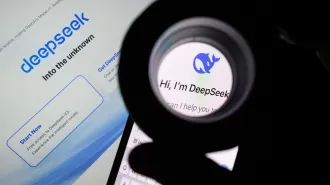On Saturday Dec. 18, 2004, at 7:30 a.m. in downtown Washington, D.C., a succession of ground-shaking explosions raced through the city’s 22-year-old convention center. Hundreds watched in awe as the immense structure, covering 11 acres, imploded within seconds into a massive heap of rubble and billowing clouds of dust (pictured below).



No one was inside. The explosions were the centerpieces of a planned demolition, bringing down a building whose value had been eclipsed by a brand-new convention center three times as large. For a team of engineers who rushed to the wreckage as soon as the last blast had faded, however, it was as if it were Sept. 11, 2001, all over again.
On that unforgettable day at the World Trade Center site, a lot went wrong with public-safety radio communications. Even before the towers fell, commanders couldn’t communicate with their units because radio signals failed to penetrate the buildings’ metal-and-glass pillars. After the thunderous collapses, rescuers found their walkie-talkies and cell phones almost worthless to reach people trapped in the debris. Finding ways to overcome communications barriers became an immediate need-to-do item for the emergency-response community.
The engineers rushing around the demolished D.C. convention center last December were taking action to meet that need. They were mapping the effects of the powerful implosion on the signals emitted from a couple of dozen radio transmitters that they had placed in the building before the blasts. These radio-communications specialists had driven from their professional home in one of the U.S. government’s top technology laboratories, the National Institute of Standards and Technology’s (NIST) Boulder, Colo., research facility. Their mission was to take the closest look so far at how radio waves, which include signals from cell phones, pass through suddenly undone structures.
Propagation through building rubble is a new realm in the study of radio signals. No one had really considered it before. But then again, until the Sept. 11 attacks, no one had seen a rubble pile 12 stories high or faced the desperate challenge of seeking survivors in such a monumental heap of debris.
The new investigations are taking place in similarly unconventional circumstances. By a combination of innovative thinking and persistence, the NIST team has won admission to a death row for buildings. Demolition companies that level buildings with explosive charges—and so are called blasters—have been letting the team plant transmitters in the ill-fated structures and then monitor signals as the buildings go down.
“This is some of the first work that’s been done on how signals propagate through rubble,” says Dereck Orr, NIST’s manager for public-safety-communications standards. By also studying intact structures, the researchers have come up with some ear-opening findings for the emergency-radio field. The payoff, the researchers say, should be better radios and enhanced communications techniques for first responders as they deal with future crises.
Blocking the airwaves
Radio signals are electromagnetic waves that travel freely through air but that can get absorbed, reflected, refracted, and diffracted by various materials. Electrical conductors such as metals, for instance, can reflect the radio energy, just as mirrors reflect light. Other building materials, such as concrete, absorb the energy of radio waves passing through. Concrete does to radio waves what dark sunglasses do to light, says Galen H. Koepke, an electronics engineer on the NIST team.
The failure of radios and cell phones to pick up signals when in concrete and metal structures is a familiar frustration both to casual users and emergency crews. In fact, after the 1993 World Trade Center bombing, the twin buildings’ owner installed a bidirectional transmitter in another structure to boost rescue signals into the towers. However, that unit apparently wasn’t operating on Sept. 11, 2001.
Even had the unit been working, its benefit would have ended as soon as the buildings collapsed. And it only stands to reason that radio communication in a matrix of rubble would become even tougher: A collapse compacts radio-stopping materials into a thicker, more radiopaque barrier.
Figuring out what to do about this problem, however, takes precise measurements of the attenuation of radio waves by different materials in various ordered or disordered arrangements.
Engineers can surmise that there’s a maze of radio-friendly pathways riddling many rubble piles, but they need to characterize those pathways and specify what might be the best frequencies to use in such places.
Armed with that kind of specific information, radio-equipment manufacturers could tailor their designs to the expected conditions. Rescuers could then choose the equipment and tactics most suitable for contacting trapped victims and each other.
How could researchers possibly generate information relevant to a disaster as great as the 9/11 collapse of the World Trade Center towers? The NIST team considered doing parking lot simulations using cinder blocks and rebar but realized that it might be able to get more-realistic data.
That’s when the team’s field leader Christopher L. Holloway started cold-calling blasters. “It took them a while to believe we were really on the level,” Holloway recalls. Once the blasters were convinced, however, the NIST team began accompanying blasters all over the nation, beginning with the implosion of a 14-story apartment building in New Orleans in Jan. 2004.
Before each implosion, the NIST team places as many as dozens of battery-powered transmitters at various locations within the condemned building. These radios are about as powerful as the walkie-talkies that emergency personnel carry. Then, using some antennae that are fixed as well as others that can be moved around on a cart, the researchers map the strengths of the transmitters’ signals outside the building, and across a range of frequencies, before, during, and after the collapse.
Two months after the New Orleans experiment, the NIST engineers were in Philadelphia for the felling of Veterans’ Memorial Stadium. Nine months later, they were in the nation’s capital, rigging the convention center for yet another set of measurements.
The team, says Holloway, plans to sample a selection of the types of large, heavily populated structures that might be targeted by terrorists or that could produce major disasters if struck by fire, earthquake, hurricane, tornado, mudslide, tsunami, or some other natural disaster.
Having a blast
If it’s any indication of how real-world the implosion tests are, they cause plenty of casualties … among the transmitters. Some are immediately crushed into permanent silence. Others make it through the experiment but then are inadvertently dumped during the demolition cleanup.
Despite the loss of about a quarter of the transmitters, the NIST team is reporting its initial findings, some of them striking. The team described results in early March in Boulder at an international conference on advanced radio technologies.
The dampening effect of rubble on radio signals that the team has measured is enormous. Nonetheless, faint radio whispers were still detectable by sensitive receivers, even though the transmitters “were covered by tons and tons of debris,” Koepke says. “There’s hope for communicating in those situations, even in the extreme cases.”
The implosion surveys are also showing that the random effects of the blasts sometimes improve radio propagation. “That’s because you’re blowing up windows and walls and you’re exposing the signals to the outside,” says Eldon Haakinson of the Institute of Telecommunications Sciences, a Boulder-based sister organization to NIST. Haakinson, an engineer, is a consultant to planners devising standards for the next generation of radio equipment for first responders.
Holloway and his coworkers are mapping radio propagation not just through condemned and collapsed buildings but also through large, terrorist-vulnerable structures not slated for demolition. These include hotels, malls, office and apartment buildings, and sports arenas.
Although many researchers have investigated the radio transparency of large, intact buildings, their studies often considered just a few frequencies and those rarely were in the bands used by first responders. Says Koepke, “We weren’t able to find a lot of good data available in the open literature.”
To help interpret all its findings, the team is conducting laboratory experiments on radio propagation through a variety of configurations of many types of materials, including steel obtained from the World Trade Center site.
So far, the new examinations of intact buildings have yielded the most surprising findings. The NIST group “is doing better mapping of the signals from inside to outside and using better methods to make the measurements than were used before,” comments Haakinson.
The team finds that at certain frequencies, radio signals that penetrate these undisturbed structures decline by as much as eight orders of magnitude, rather than the expected two or three.
“It’s not surprising that we have trouble getting signals in and out,” says Holloway. The high attenuation figures should be news to building designers, he adds.
By comparison, the signal strength in rubble is routinely four to five orders of magnitude lower than that in air, Holloway says. At a few locations, it diminishes by yet another factor of 1,000.
The examinations of intact buildings are also underscoring how difficult it is to generalize about building characteristics. During measurements in Phoenix, for instance, the team found that radio signals behaved dramatically differently in two office buildings that were made of steel and plate glass and looked nearly identical. The likely reason? Different types of window tinting. The coating on one of the buildings is a better electrical conductor, which means it reflects more sunshine and radio waves than does the tinting of the other building.
Breaker, breaker
A simple metallic conductor may prove important in a rubble pile as well. Beyond just characterizing buildings and rubble according to their radio environments, the NIST project is testing ways to help rescuers get through the communication barriers that they might face during a disaster.
For example, the researchers are quantifying the effect of touching a metal radio antenna to ventilation ducts, pipes, or other metal debris in the wreckage. That contact can turn the metal into an extension of the antenna on the typical radio or cell phone, to better the odds of broadcasting out of the wreckage.
Tests so far have been at least a little promising. Deploying transmitters with their antenna touching metal in their surroundings provides about a 10-fold boost in signal strength, says Kate A. Remley, an electronic engineer and leader of the NIST project on radio wave propagation. Still, that boost is far too small to overcome the silencing effects of debris heaps, she notes.
In another approach, this one adapted from NASA’s Deep Space Network—and already well-known to ham-radio operators—the NIST workers are testing the possibility of detecting a simple signal like the ones used to communicate with distant spacecraft.
A rudimentary distress signal, such as an SOS in Morse code, on a narrow frequency band might be easier to extract from the radio clutter than a plea for help spoken in words. To be intelligible, words must be received simultaneously on a wider band of frequencies than the one required for a simple signal of long and short pulses.
In tests of this tactic, receivers have picked up and decoded the Morse code-style signals through post implosion rubble. However, the computations needed to pluck the signals from the ambient radio static remain too sophisticated and time-consuming to be feasible in emergency workers’ radios, Koepke says.
Although the NIST team hasn’t solved the communication challenges likely to crop up in natural and human-made disasters, its work is drawing the attention of Haakinson and other engineers.
“The technology the public-safety community is using is basically what was developed in World War II,” says Haakinson, who serves as a technical expert on a committee of wireless manufacturers, public-safety officials, and government representatives that’s developing equipment standards. “It’s only in the past 10 years that public safety has finally been getting into the digital world,” he notes.
With burgeoning capabilities for digital-information processing, wireless communications, and networking now available, such committees are contemplating an exhilarating future.
In some scenarios, for instance, emergency-response commanders distant from a disaster scene would electronically monitor the position and vital signs of every first responder. The committees are considering whether such capabilities are achievable within technical and financial constraints.
Orr says that those decision makers need the type of new data that the implosion work is providing.





